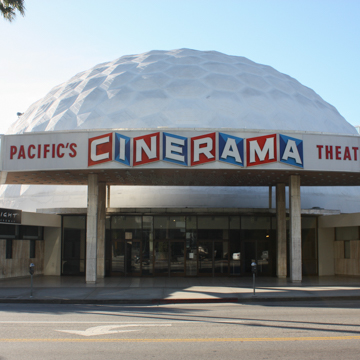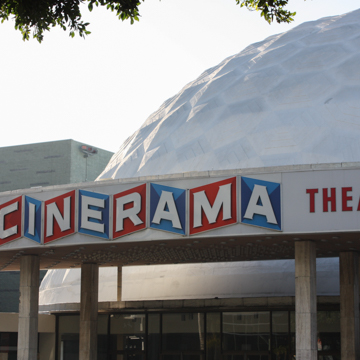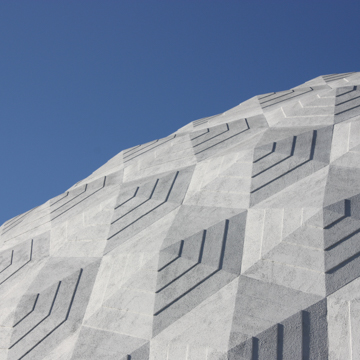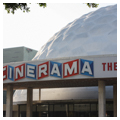In a city with no shortage of movie theaters, none can compare to the great Cinerama Dome, an icon of modern architecture. It was designed by Welton Becket and Associates, one of the most prolific Los Angeles–based architectural firms of the twentieth century. The firm worked with developer Saul Pick, who was interested in creating a structure that could be erected quickly and efficiently, saving on cost without sacrificing square footage.
Pick was inspired by Buckminster Fuller’s patented geodesic dome concept, which had become popularized by the 1960s. Cinerama was unique, however, in that it was the first geodesic dome in the world constructed of concrete. Intended to be the first of many theaters of this type built around the country, the design never spread. Although concrete geodesic domes are in existence, Los Angeles’s Cinerama Dome remains a unique example of this approach to theater design.
Spanning over seventy feet in height and weighing more than 700 tons, the dome sits on a sixteen-foot-high circular concrete base. The dome comprises 300 interlocking precast concrete pentagons and hexagons, each weighing about 3,200 pounds and averaging eight square feet in size. Construction cost half as much as most conventional theaters and took half the time—just seventeen weeks of twenty-one-hour work days.
The Cinerama process, first developed in 1952, requires three projectors and a curved ninety-foot screen. Before the Cinerama Dome was finished, the process was abandoned because of expense and technical difficulties. For this reason, the structure is a rare example of a surviving, functional Cinerama theater. This includes maintaining the curved screen format required for the system.
Completed in 1963, the Cinerama Dome opened in time for the premiere of It’s a Mad, Mad, Mad, Mad World, which ran for 66 weeks. From that point forward, the Dome became a popular location for star-studded Hollywood premieres. The Cinerama Dome also joined other Becket buildings such as the Capitol Records Tower, the Beverly Hilton, and the Music Center of Los Angeles County as a forward-looking example of Los Angeles modernism.
In 1998, owner Pacific Theatres proposed a plan that would have eviscerated and engulfed the Dome. The Los Angeles Conservancy, Hollywood Heritage, and Friends of Cinerama worked together on a successful effort to preserve the Dome; it was designated a Los Angeles Historic-Cultural Monument in 1998. Pacific Theatres carefully rehabilitated the structure, including installing a new screen and specially designed acoustic system. It reopened in 2002 as the centerpiece of the new ArcLight Hollywood. The iconic dome remains a highly visible Sunset Boulevard landmark and offers an incomparable cinematic environment. Its smooth curves and sweeping interior features highlight the organic side of modern design, evoking the arc of the night sky.
References
Los Angeles Conservancy. Built by Becket. Tour script, 2003.
Los Angeles Conservancy. 20/20/20: Highlights from Past ModCom Events and Preservation Issues. Tour script, 2004.
Los Angeles Conservancy. “Cinerama Dome.” Accessed January 28, 2016. https://www.laconservancy.org/.






